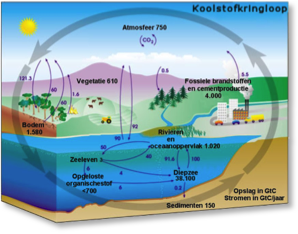Sicirec - Definitions
Carbon cycle
Carbon dioxide (CO2) is one of the main greenhouse gases. It is essentially a harmless gas which occurs naturally in the atmosphere. CO2 is part of the natural carbon cycle (C).

This cycle can be divided in an organic and inorganic cycle, which in turn can be divided in a short- and a long-term cycle.
The carbon cycle maintains a measure of natural balance between the amounts of carbon present in the atmosphere (CO2), in water (dissolved CO2) and in the biosphere (chalk, mineral oil, natural gas, coal).
However, the balance shifts as conditions and concentration change, for example if levels of CO2 are continuously increasing. An increase of the CO2 concentration in the atmosphere remains mainly unobserved, as it can not be smelled or seen.
An increase of the CO2 concentration in the atmosphere is caused by the combustion of fossil fuels such as mineral oil, natural gas and coal.
From the start of the industrial revolution around 1850, the combustion of fossil fuels started to increase. Since then, the amount of CO2 in the atmosphere has increased by almost 30%.
In the Netherlands, industry, the energy sector, cars, aviation and domestic use of electricity are the main causes behind the increase in CO2- emission.
A carbon dioxide equivalent is a measure to compare the effects of different greenhouse gases. It is based on the Global Warming Potential (GWP), the measure in which a gas contributes to global warming compared to an equivalent mass of CO2.
Methane for example has a GWP of 21, which means that 1 pound of methane has an effect 21 times greater than 1 pound of CO2.

